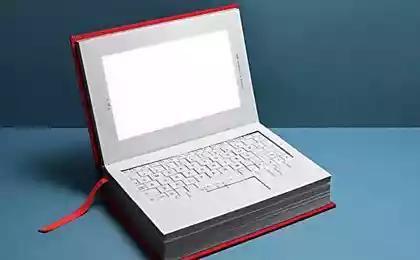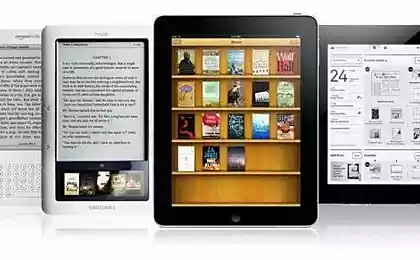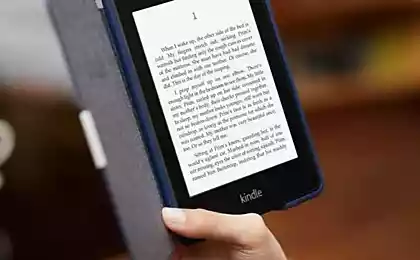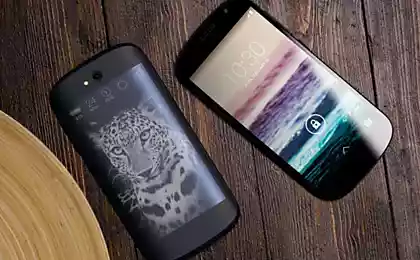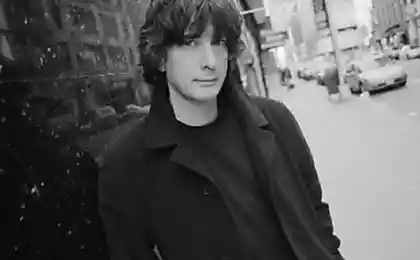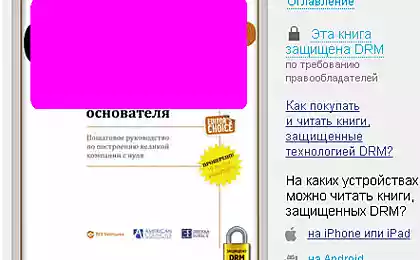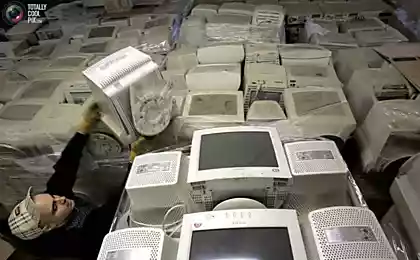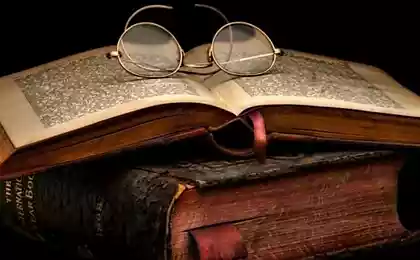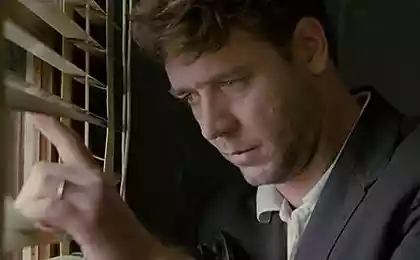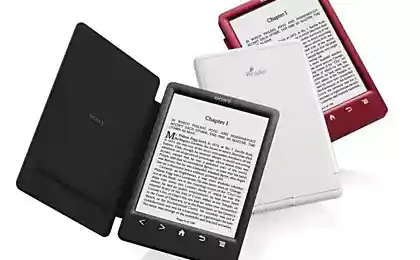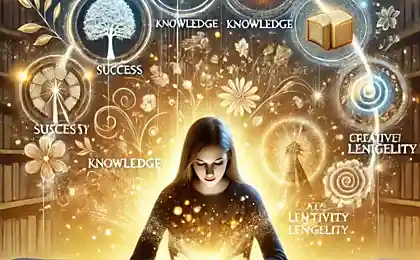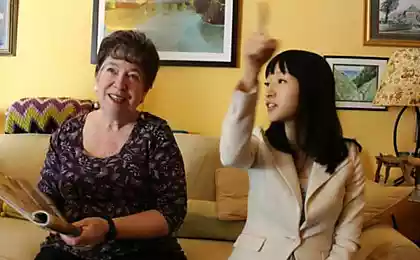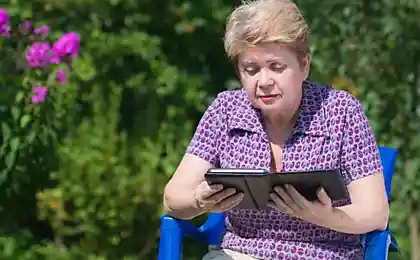1712
The future of e-books
Mankind is still reading the book. H4>
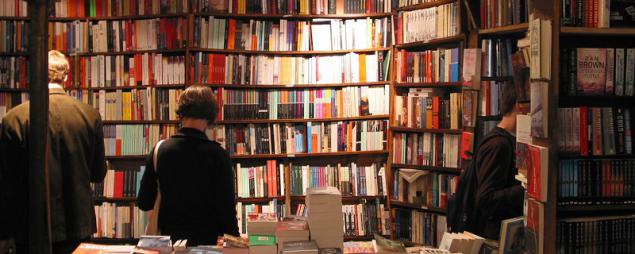
Perhaps mankind began to read less than once, with the advent of social networking and various other news sources updated continuously. Yet the book remain with us. Often, seeing a new book on sale, we want to buy your own copy, and the subject of desire is just a paper version. This happens for different reasons - someone wants to feel again the smell of freshly printed pages, someone wants to touch the thing and the "severity" of words on the pages in a binder, which can be put on the shelf racks in your collection, and someone will read from the countless reviews that with the electronic version you will have trouble, but still! How did it happen that in the age of electronic technology, we will have trouble reading the electronic edition? Is it really all that bad? The answer to this question is ...
Yes ... as well as No.
Art text h4>
When it comes to fiction, most recently a huge number of devices on the electronic ink, read that at first glance seems a pleasure. However, they are not perfect, though, and provide an excellent opportunity to reduce the library to a small gadget, the dimensions of which allow without any impediments to take it with you wherever you go. Furthermore, this device three times thinner than the average of the book, not to mention how easy it can be. With a pocket we can be all the collected works of your favorite author, though, how many languages. I would not want to focus only on the literature, but a few comments to all devices for reading, in principle, available, and to voice their worth.
Turn h5>
All units have only one main screen, and no matter how we tried to fit in all the information completely, a full replacement of the book is not one screen. It is, rather, a scroll, and, thanks to flexible displays, already at this point we can imagine a device that repeats the construction of the "scroll" in general. All that we are now on the market are electronic scrolls, and not e-books.
The turn itself provides two work surfaces from which we receive information. It is convenient to work like a book because we can cover eye 2 times more information than a single page. We often use this simple device of the book, to take a view of what has been read a few seconds ago. Now remember a time when you flipped the page, but suddenly entangled in the story and flip over backwards to better understand what they mean. At the same time we keep the page vertically and associate text with "person" and "wrong side" of one page - not too comfortable, but we use this technique, but with a full reversal would be better.
Perfect reversal will be the one in which the activity is to the right side and the left shows the previous page. After turning we're still going to look at the right side, but can always take a look and the previous page without the need for a clever way above the vertical viewing pages on both sides.
turning mechanism h5>
In recent years, many devices have moved from mechanical buttons to touch screen. However, if we recall the turning speed and the lack of tactile feedback, we sometimes find ourselves in a situation where there is no turning, or so it seems to us - and we turn over again, appearing through the front page. If we remember flipping through the paper book, it is a sequential process of several steps that takes some time. In comparison, a slight delay in the process of turning the e-book will be appropriate. The key points are turning two things - the feeling that we just teased the next page (often we even further, and even more than once a check whether the page we picked up), as well as fixing a new turn after the ritual turning. It is important that flipping was correct, and we want to be sure. So how did it happen that the device out of love for their developers with a mechanism of interaction, we stopped to answer this reliability? Lack of tactile feedback when there is constantly turning. And if we implement it, it is desirable double beep, notifying the beginning and the end of the turning. After all, common mechanical button was previously acceptable option - it we do feel a click or a click when you press. And if mechanical buttons, then arrange them still convenient to the right and left turn. If you remember this book, the lower or upper corner, but not below the work area! Left - just at the top and on the right, if it is certain - you can add as many as two buttons (note: we are talking about reading from left to right). Touch recoil mechanism misleading anyone who has ever worked with him - we know that you need only one touch to get the effect. The problem is that the routine ritual of flipping has become a tricky game with touch interaction mechanism.
Technical literature h4>
For most of the audience of this article is important aspect of technical literature. And in this respect, unfortunately, readers lose the paper version. As if the lack of reversal we can somehow be reconciled, and can even completely get used to scroll through the proposed mechanism, the inability to obtain information of this convenient, alas, did not happen.
Diagonal h5>
Mostly around us multiple devices small diagonal (around six inches). See most charts, graphs and tables on this screen is very difficult. The main problem of the small diagonal - the inability to see the book in its original form, which is a hard copy. The form in which the author finally agreed upon it with the editor. Form in which the editor is fully accepted it, with all the "magical properties" books such as "turn" and the associated layout information.
But, you will object, there are devices with larger diagonal! All these devices are, of course, exist, but you have seen among them any meaningful competition? As a consequence of this - have you seen the price of these devices? Did you know that the largest manufacturer of electronic devices of this type in some point simply refused to large diagonals? Did you finally reviews specific users? All of this picture not too enthusiastic.
New same, not yet released to the public media devices, offering the latest 13 & quot; screen manufacturers try to put as something beyond professional, corporate, and as a result, we again see a device with a very clear, but broad functionality for which demand an inadequate amount. If we want to just read from the big screen, the holiday as already become a tradition over the past few years, will be held on the sidelines.
Color h5>
Do you really interested in this factor? It's important to play your books with bright vivid colors? And now the name, number of colors, no, not even that - how many shades of gray, you need to distinguish between the average graph or chart. Remember, what are the possibilities of electronic ink at the moment (note: We deliberately omit the progress of the color e-ink, t. To. All that is available on the market, produce low impression). You still want to color?
In fact, the prior art does not need such a large color appears much. In recent years, we find a color other than charts and graphs - and that is not always - exclusively for unnecessary advertising book publishing, a beautiful selection of subtitles, and, of course, and cover it all! There is virtually no options in which we do not have enough available shades of gray.
The only bright and colorful in the book - it's a cover, to see which is very well suited separate screen no more than two or three inches, which will show all its colors, if you want it. Devices that combine two different screen already out, and this version is a mixture of conventional books and a very nice supplement to it.
Conclusion of the first h5>
You already seems to be quite a good device for reading, having a complete reversal, the long diagonal, and an appropriate mechanism for turning a nice addition in the form of very small, but the glossy color cover. In the case of a turn implemented a color cover can be taken out, so as not to open the book could "wake up" the unit and look at what the book we stopped, and perhaps see the bookmark, and any other relevant information.
The device near future h4>
And now, some thoughts on the subject. Perhaps you too have come to them, and, as already mentioned in the previous article - & quot; ... the idea is always hovering around us. It often happens that, opening in the morning to read the news, we see exactly what thought recently, but have left about a single record. & Quot; Let's try to put together some expected and it is implemented by chance. Capabilities of the device not only for reading, and for the perception of information in general.
A new screen h5>
Recently, we often hear mention of flexible displays. Yes, at least some of them future. A future in which we will be able to halve the size of the device, just fold it. Prototypes of devices with this technology we have already met, therefore no doubt that the problem of pixels in the crook was solved, there is no reason. But is it really so important? For fiction - definitely not - in any book there are fields, which adhere certainly worth that completely eliminates the need for the crook of the screen. For large as devices designed more for the technical literature, it is very useful in order to maintain compactness - remember the newspaper, they always folded during transportation. However, the folding device contains twice and minus, t. To. Will destroy the idea of "turn", so for larger devices more reasonable is to add to the cover, which will be built in the second work surface. For universal device, which will be discussed further, this technology will be useful.
Let's digress from flexible displays and recall transparent displays. Yes, these were also, but they are almost forgotten, not having time to really learn and test the technology in the end devices. Recent developments are indeed impressive, featuring a fully transparent surface dynamic image. Their only drawback - they need a backlight. Prototypes have successfully coped with this by showing brightly lit boxes with the advertised products on a transparent door which was situated such a display.
We were close enough to the key idea of the new device. Recall the last e-books. There are already at least a couple of generations of devices with full backlight, and the first thing that comes to mind - to make it on top of the transparent display backlight! Quite obvious, is not it?
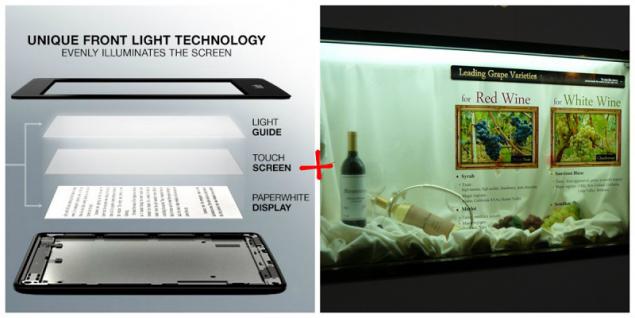
This unit will combine the benefits of e-paper, along with a modern color display. At the time of content playback on the color display, the only thing to do - clean background on the substrate, and turn on the backlight. At other times, the backlight is not necessary. We can at any time to switch between the two displays. For example, reading an article in a magazine, referring to the video, we can touch the screen, and text over the video will appear in all the splendor of flowers. Illustrations can also "paint" one touch.
Other features h5>
Number of functions of the gadget is always a trade-off between performance and power consumption. Yet it is worth noting that having a perfect screen on your device, you can have all the functions of a modern tablet. On the other hand, considering the target audience of the device, it is clear that it needs only basic functionality as the browser. Everything else should be localized around the reading itself. Of revolutionary ideas used in the past few years, it is worth mentioning only indication of time before the end of the current chapter reading - yes even display a number of pages to the end of the chapter is already appropriate to add to all devices. It is also very interesting, but rarely is the meeting point of time spent on reading books, and (or) spent at the device as a whole. Statistics depressing - in Russia at the moment it is known that more than a third of the population does not read books at all. So, perhaps, for someone indication of time will encourage to read more pages, faster reading, and as a whole - a little competitive element for all existing devices. And if you add to it, "Achievement" for reading the classics, the winners of literary prizes, or popular best-selling, as well as - updated list of relevant literature on the trades and so on., The usefulness of such devices will grow at times.
Conclusion second h5>
Thank you very much for having read up, or at least viewed diagonally this article. If you have any idea about all this - ask in the comments! Sad to see how the e-book device luxury and "not for everyone", suddenly became obsolete class of devices. Almost any store will advise you to buy a tablet instead of a normal book on electronic ink. But still want to believe that manufacturers are able to produce a good device, and it is already waiting for us in the prototypes are being tested right now behind closed doors.
P.S. Couple renders these concepts h4>
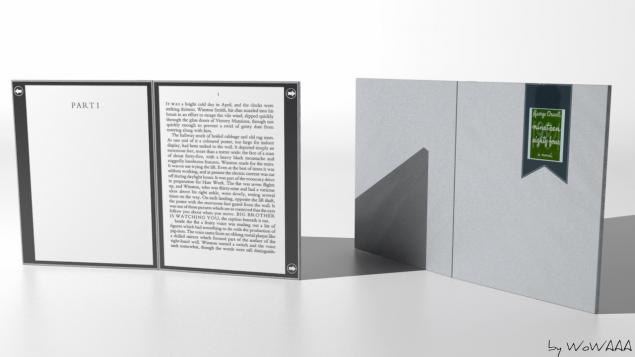
The first device you are already familiar to the description of the device for reading fiction. The only addition is the external color display, which was mentioned a little later.
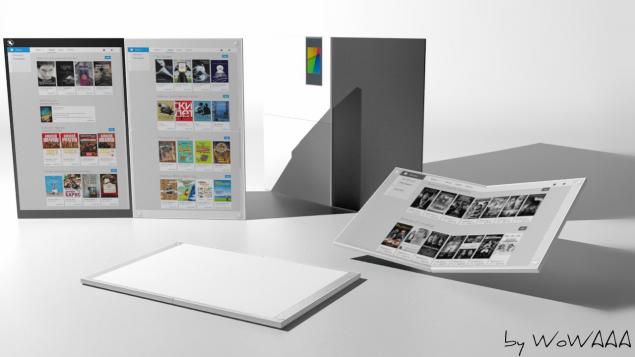
The second render shows the device of the final part of the article. The device can display both color and "paper" content, as well as combine both possibilities in the imposition. Due to the flexible display device can be folded in half, and as an accessory to it can be a more thin cover, which has the same screen, only without the possibility of folding it in half. Cover highlighted in black in the figure, and is fastened to the fixed device in the open position.
Source: habrahabr.ru/post/210362/
April 18: World Day launch balloons in the stratosphere
Sony plans to sell the business to produce Vaio PC




